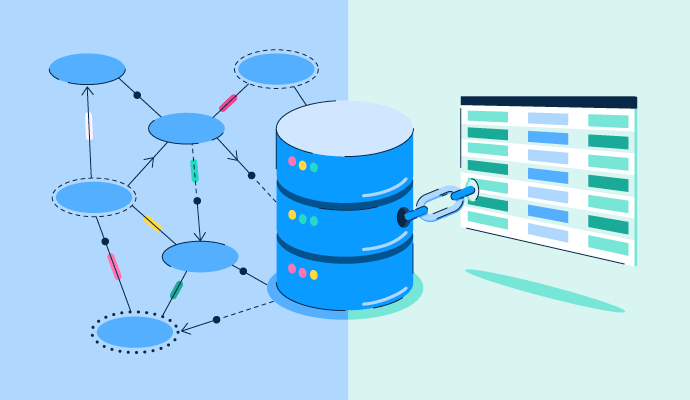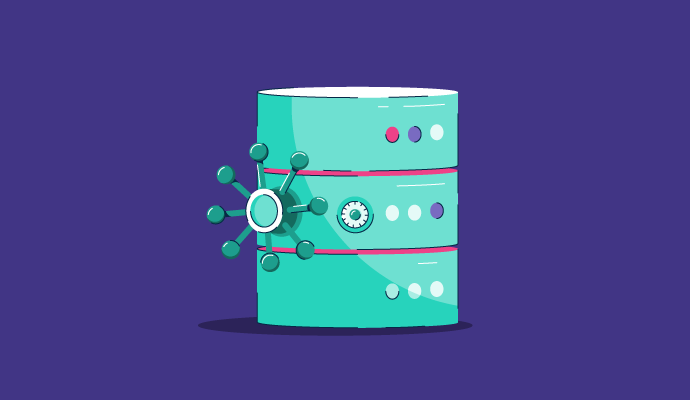Data remains an invaluable resource. When processed properly, it fuels savvy business decisions. How you store data has a lot to do with the ways you’re able to further process it.
Databases come in handy when you need to hold onto information that will help you make better choices. Different types of databases, such as graph databases, vector databases, and relational databases, have specific purposes and use cases.
In this article, we’ll help you learn about graph database vs relational database, including how they differ from one another.
Graph database: an overview
A graph database is a NoSQL database that stores information as a network graph. It has four components.
- Nodes, also called vertices, comprise the main entities of a graph.
- Relationships are the connection between those entities. They’re called edges or links.
- Labels are attributes that aggregate similar nodes.
- Properties are key or value pairs stored within those relationships or nodes.
Related: SQL vs. NoSQL databases: which one is right for you?
Graph databases handle data with complicated relationships more adeptly than relational, making them ideal for a wide range of applications.
The flexible format of a graph databases representation allows it to perform better than a relational database. It uses index-free adjacency, which means each network node contains pointers to related nodes.
As a result, the node provides access to extensive indices so performance improves depending on the number of traversal relationships.
Graph database applications
Graph databases capably generate and query data with complex relationships and show value in the uses cases below.
Fraud detection
In case of credit card fraud, graph databases highlight shared identifiers like social security numbers or addresses associated with the affected card. Known as link analysis, this technique works by evaluating nodes and edges within a network.
Recommendation engines
The graph database works great for applications that provide suggestions. It’s possible to save graph links between data types like customer interests, friends, and purchase history.
You can set up a widely available graph database to recommend products to users based on which products have been purchased by people with similar interests and buying histories.
These recommendation capabilities make graph databases useful in e-commerce and social networking platforms.
Route optimization
Route optimization examines a dataset and determines the values that best suit a certain scenario. For instance, use a graph database to:
- Find the quickest route from point A to B on a map, considering all possible paths.
- Analyze various availability, locations, and capabilities to choose the best employee for a specific shift.
- Order the most appropriate machinery for operations, considering factors such as cost and equipment lifespan.
Pattern discovery
Graph databases identify complicated interrelationships and hidden patterns in data. To give an example, a social media platform might employ graph databases to differentiate between bots and legitimate accounts.
When to use a graph database
Answers to these questions will help you understand whether a graph database is the right fit for you.
- Do you plan to analyze complex interconnected data? If so, a graph database is a suitable option.
- Do you work with a data model with a strict schema? If yes, it’s better to go with a relational database.
- Do you have path-based queries? If yes, go with graph databases.
- What matters more: performance or massive datasets? If it’s the latter, go with graphs.
- Would you need to perform full ACID transactions? If yes, choose relational databases.
- Do you use the Create, Read, Update, and Delete (CRUD) pattern while accessing the database? A relational database will suffice if that’s the case.
Graph database examples
Here are some popular graph database examples:
- Neo4j: A widely used, open-source graph database known for its powerful querying language Cypher. It is well-suited for a wide range of applications, including social networks, recommendation systems, fraud detection, and knowledge graphs.
- Amazon Neptune: A fully managed graph database service offered by Amazon Web Services (AWS). It is designed for high-performance graph workloads and is optimized for handling large-scale graph datasets.
- Dgraph: A distributed graph database that offers a unique approach to data modeling and querying. It is designed for highly scalable and performant graph applications.
- ArangoDB: A multi-model database that supports documents, graphs, and key-value pairs. It offers a unified query language (AQL) to query all data models.
¿Quieres aprender más sobre Bases de datos gráficas? Explora los productos de Bases de datos gráficas.
Relational databases: an overview
A relational database stores data in the form of tables. Tables function similarly to physical file cabinets, as each folder contains information on a topic.
A relational database connects data according to logical relationships. Because data is recorded in tables, it has a logical and straightforward structure. Rows are unique records with identifiers; columns identify the attributes of a data set. The tables are then joined together using relationships.
Let’s say you wanted to gather all of the buyers who live in a specific city. You start with your "customers" table. Then you go to your "cities" table and look for the city you're interested in. Finally, you combine the two tables to find all the customers residing in that city.
Why do you need relational databases?
Relational databases are critical for applications that need structured data storage and transactional integrity. They are suitable for:
- Dealing with structured data. Relational databases are handy in situations when the data structure is well-defined and rigid. If data is correctly structured into tables with established columns and relationships, a relational database is the best choice for analytics.
- Ensuring atomicity, consistency, isolation, and durability (ACID) compliance. A relational database is best if your application requires robust ACID compliance to assure data integrity and reliability. This is particularly important for applications like financial systems and medical records.
- Having a well-defined schema. If your application requires fewer data modifications, relational databases can methodically accept these changes. This is useful in cases where the data structure is relatively stable.
- Ensuring data security and access control. When data security and access control are critical, relational databases provide a solid foundation for controlling user rights and safeguarding sensitive data.
When to use a relational database
Relational databases have a standardized schema. They’re a suitable option when:
- You’re working with structured data.
- Your application involves complex JOIN operations between tables.
- ACID compliance and transactional consistency matter a lot.
- Data relationships are straightforward, and foreign keys can effectively represent them. A foreign key is a column or a set of columns in a table that refers to primary key values from a different table.
Relational database examples
Here are some of the common relational database examples:
- MySQL: A widely-used, open-source relational database known for its performance, reliability, and flexibility.
- PostgreSQL: A powerful, open-source relational database that supports advanced features like complex data types, full-text search, and spatial data extensions
- MariaDB: A fork of MySQL, known for its performance and compatibility with MySQL.
- Oracle Database: A comprehensive database platform offering a wide range of features, including high availability, security, and scalability.
- IBM Db2: A robust and scalable database platform, often used in large-scale enterprise applications.
Graph databases vs. relational databases: key differences
Both graph and relational databases store bits of data related to each other in particular ways. However, they represent the relationships between these pieces of information quite differently.
A graph database organizes data as a network of entities and relationships. It uses mathematical graph theory to store and operate on data relationships. They model these relationships more effectively than relational databases, significantly improving application performance.
Relational databases hold information in tables with rows and columns. Unlike graph databases, they tend to become inefficient in operations involving complex data relationships because they require several data table lookups.
Here, we examine the key differences between graph database vs relational database through five aspects.
- Data model. Relational databases keep data in tables with rows and columns, making them the most suitable option for structured, well-defined information. They make it difficult to represent many-to-many relationships.
Conversely, graph databases use nodes and edges to represent data with flexible relationships, showing them as they behave in the real world. Since the importance of relationships increases in graph databases, you can connect data more naturally.
- Schema flexibility. Relational databases may require a fixed schema that might be rigid when dealing with dynamic or semi-structured data.
A graph database allows you to change the schema as your database expands.
- Query language. Relational databases frequently use SQL in their queries. SQL is designed to work with tabular data and has a steep learning curve.
Graph databases use Cypher query language. Cypher’s syntax and functionality make it appropriate for querying many-to-many relationships. Think of Cypher as a way to map English language sentence structure to patterns in a graph where : nouns usually stand in for nodes; verbs for relationships;and adjectives and adverbs for properties.
- Scalability. It’s easier to scale graph databases quickly across multiple machines to accommodate massive datasets and high transaction volumes.
Users may find it hard to scale efficiently with relational databases. As data grows, it becomes more distributed, disrupting the structure. Using multiple servers affects database performance and impacts application response time and availability.
- Complexity. Relational databases have data models that simplify set-up and maintenance.
Even though creating and querying graph databases can become more complex, they work faster on complex, relationship-based data. However, poorly constructed graph queries can drag down performance if you’re not careful. Graph databases may take your team through a learning curve since they’re still evolving.
Graph database vs relational database: Frequently asked questions (FAQs)
What is the difference between a relation and a graph?
Relation (in relational databases) is table with rows and columns, representing a set of tuples. Relationships between data are defined through foreign keys.Whereas, a graph is a collection of nodes (entities) connected by edges (relationships). Graphs are more flexible and can represent complex and dynamic relationships.
Is SQL a graph database?
No, SQL (Structured Query Language) is the standard language for querying and manipulating data in relational databases.
Is MongoDB a graph database?
No, MongoDB is a document-oriented database. While it can store and query documents with embedded relationships, it's not specifically designed for efficiently handling complex graph structures and traversals.
Is PostgreSQL a graph database?
No, PostgreSQL is a powerful relational database. While it can be used to model some graph-like structures, it's not as efficient or optimized for graph traversals as dedicated graph databases.
Making a perfect choice
Choosing between a graph and a relational database depends on your requirements and use case. Evaluate the purpose for which you intend to use the database. If it’s a use case where relationships between data matter more, like in social networks or product recommendations, go with graph databases.
On the other hand, when your data is more structured, a relational database supports you easily.
Learn more about relational databases and understand why database engineers prefer working with them.

Sagar Joshi
Sagar Joshi is a former content marketing specialist at G2 in India. He is an engineer with a keen interest in data analytics and cybersecurity. He writes about topics related to them. You can find him reading books, learning a new language, or playing pool in his free time.

